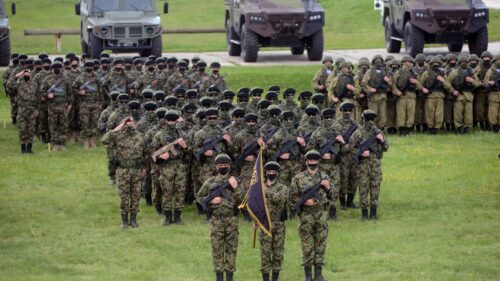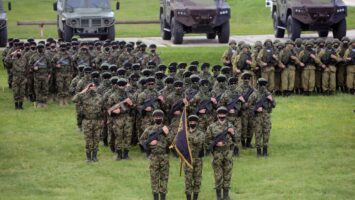
Last month Serbia and Russia held joint military exercises near Belgrade as U.S.-led forces held massive drills (see details below) in neighboring Balkan states. The Serbian and Russian defense ministries said the joint training of some 200 special troops will include “the destruction of an illegal military formation,” live ammunition shooting and “anti-terrorist” action.
The exercises came as large-scale U.S. Army-led drills code named DEFENDER-Europe 2021 were held across Europe, including in most of the nations that neighbor Serbia in the former Soviet satellite of Yugoslavia. As you can see from the map, just only country separates Serbia from Ukraine, a much desired asset of Russia’s premier Vladimir Putin, who has already annexed Crimea and is making a play for “the breadbasket of Europe” as Ukraine was once known. Currently, no gas or oil from Russia is entering Ukraine and they are suffering as a result. Putin is currently dripping poison about Ukraine into the willing ear of Biden-Harris who just withdrew objections to the Russian pipeline Nord Stream II which runs underneath the Baltic Sea to the north and will send fuel to Europe. To distract from seizing Crimea, Putin staged an invasion of Ukraine. As with all Balkan politics – it’s complex. But the fact that NATO is still treating the area as a high-risk area is telling. Let’s hope it doesn’t descend into violence —Again.

DEFENDER-Europe is an annual large-scale U.S. Army-led, multinational, joint exercise designed to build readiness and interoperability between U.S., NATO and partner militaries. This year’s exercise:
- Focuses on building operational readiness and interoperability with a greater number of NATO allies and partners over a wider area of operations
- Is defensive in nature and focused on responding to crisis if necessary
- Demonstrates that the U.S. commitment to NATO is iron clad
- Integrates approximately 28,000 multinational forces from 26 nations to conduct nearly simultaneousoperations across more than 30 training areas in 12 countries.
- Includes strict COVID prevention and mitigation measures, such as pre-deployment COVID testing andquarantining.
- Has significant involvement of the U.S. Air Force and U.S. Navy.
- Utilizes key ground and maritime routes bridging Europe, Asia and Africa
- Exercises new high-end capabilities such the new U.S. Army Security Force Assistance Brigades, airand missile defense assets and the recently reactivated V Corps
- Demonstrates our ability to serve as a strategic security partner in the western Balkans and Black Searegions while sustaining our abilities in northern Europe, the Caucasus, Ukraine and Africa.Timeline of DEFENDER-Europe 21:
• March – equipment and personnel from the United States will begin moving to Europe.
• April – Army Prepositioned Stocks will be drawn from sites in Germany, Italy and the Netherlands; thenmoved to various training areas via convoy, rail, line haul or barge. This phase of the exercise will demonstrate U.S. Army Europe and Africa’s ability to maintain a deterrent posture in northern Europe while concurrently shifting forces to other areas of the theater.
• May – The bulk of activities will occur with training events across more than 30 training areas in 12 countries and encompassing several linked and associated exercises:o Immediate Response – more than 5,000 troops from 11 countries will spread out across 31 training areas to conduct live fires. A Joint Logistics Over-the-Shore operation will also occur.
o Saber Guardian – more than 13,000 service members from 19 countries will conduct live fires and air and missile defense operations, plus a large scale medical evacuation.
o Swift Response – will include airborne operations in Estonia, Bulgaria and Romania involving more than 7,000 troops from 11 countries.
o African Lion – nearly 5,000 military personnel train on medical readiness, perform large-scale live-fire exercises and conduct air, maritime and forward command post training exercises.
o Steadfast Defender – a new series of NATO exercises focused on the transatlantic reinforcement of Europe and demonstrates NATO’s capability to respond rapidly to the full spectrum of threats.
• June – a Command Post Exercise involving approximately 2,000 personnel to demonstrate the headquarters’ ability to command multinational land forces in a joint and combined training environment while maintaining real-world operations across 104 countries on two continents. DEFENDER-Europe 21 will conclude with the redeployment of U.S.-based forces and equipment. U.S. service members will clear the training areas, return prepositioned stocks, move to ports and return to home stations – fulfilling the U.S. military’s commitment to the NATO agreements.
